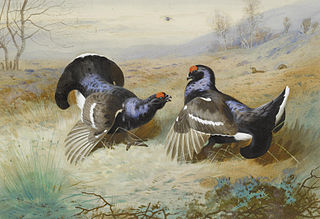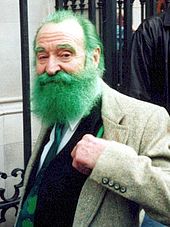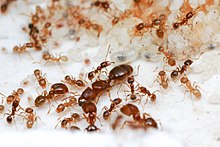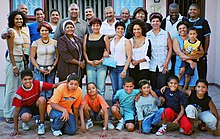
In evolutionary biology, reciprocal altruism is a behaviour whereby an organism acts in a manner that temporarily reduces its fitness while increasing another organism's fitness, with the expectation that the other organism will act in a similar manner at a later time.

The Selfish Gene is a 1976 book on evolution by ethologist Richard Dawkins, in which the author builds upon the principal theory of George C. Williams's Adaptation and Natural Selection (1966). Dawkins uses the term "selfish gene" as a way of expressing the gene-centred view of evolution, popularising ideas developed during the 1960s by W. D. Hamilton and others. From the gene-centred view, it follows that the more two individuals are genetically related, the more sense it makes for them to behave cooperatively with each other.

Group selection is a proposed mechanism of evolution in which natural selection acts at the level of the group, instead of at the level of the individual or gene.
In evolutionary biology, inclusive fitness is one of two metrics of evolutionary success as defined by W. D. Hamilton in 1964:
Evolutionary game theory (EGT) is the application of game theory to evolving populations in biology. It defines a framework of contests, strategies, and analytics into which Darwinian competition can be modelled. It originated in 1973 with John Maynard Smith and George R. Price's formalisation of contests, analysed as strategies, and the mathematical criteria that can be used to predict the results of competing strategies.
"The Genetical Evolution of Social Behaviour" is a 1964 scientific paper by the British evolutionary biologist W.D. Hamilton in which he mathematically lays out the basis for inclusive fitness.
The gene-centered view of evolution, gene's eye view, gene selection theory, or selfish gene theory holds that adaptive evolution occurs through the differential survival of competing genes, increasing the allele frequency of those alleles whose phenotypic trait effects successfully promote their own propagation. The proponents of this viewpoint argue that, since heritable information is passed from generation to generation almost exclusively by DNA, natural selection and evolution are best considered from the perspective of genes.
In biology, altruism refers to behaviour by an individual that increases the fitness of another individual while decreasing their own. Altruism in this sense is different from the philosophical concept of altruism, in which an action would only be called "altruistic" if it was done with the conscious intention of helping another. In the behavioural sense, there is no such requirement. As such, it is not evaluated in moral terms—it is the consequences of an action for reproductive fitness that determine whether the action is considered altruistic, not the intentions, if any, with which the action is performed.
The green-beard effect is a thought experiment used in evolutionary biology to explain selective altruism among individuals of a species.
In evolution, cooperation is the process where groups of organisms work or act together for common or mutual benefits. It is commonly defined as any adaptation that has evolved, at least in part, to increase the reproductive success of the actor's social partners. For example, territorial choruses by male lions discourage intruders and are likely to benefit all contributors.
Kin recognition, also called kin detection, is an organism's ability to distinguish between close genetic kin and non-kin. In evolutionary biology and psychology, such an ability is presumed to have evolved for inbreeding avoidance, though animals do not typically avoid inbreeding.

Eusociality, the highest level of organization of sociality, is defined by the following characteristics: cooperative brood care, overlapping generations within a colony of adults, and a division of labor into reproductive and non-reproductive groups. The division of labor creates specialized behavioral groups within an animal society which are sometimes referred to as 'castes'. Eusociality is distinguished from all other social systems because individuals of at least one caste usually lose the ability to perform at least one behavior characteristic of individuals in another caste. Eusocial colonies can be viewed as superorganisms.

Eusociality evolved repeatedly in different orders of animals, notably termites and the Hymenoptera. This 'true sociality' in animals, in which sterile individuals work to further the reproductive success of others, is found in termites, ambrosia beetles, gall-dwelling aphids, thrips, marine sponge-dwelling shrimp, naked mole-rats, and many genera in the insect order Hymenoptera. The fact that eusociality has evolved so often in the Hymenoptera, but remains rare throughout the rest of the animal kingdom, has made its evolution a topic of debate among evolutionary biologists. Eusocial organisms at first appear to behave in stark contrast with simple interpretations of Darwinian evolution: passing on one's genes to the next generation, or fitness, is a central idea in evolutionary biology.
Microorganisms engage in a wide variety of social interactions, including cooperation. A cooperative behavior is one that benefits an individual other than the one performing the behavior. This article outlines the various forms of cooperative interactions seen in microbial systems, as well as the benefits that might have driven the evolution of these complex behaviors.
The theoretical foundations of evolutionary psychology are the general and specific scientific theories that explain the ultimate origins of psychological traits in terms of evolution. These theories originated with Charles Darwin's work, including his speculations about the evolutionary origins of social instincts in humans. Modern evolutionary psychology, however, is possible only because of advances in evolutionary theory in the 20th century.
Darwinian anthropology describes an approach to anthropological analysis which employs various theories from Darwinian evolutionary biology. Whilst there are a number of areas of research that can come under this broad description some specific research projects have been closely associated with the label. A prominent example is the project that developed in the mid 1970s with the goal of applying sociobiological perspectives to explain patterns of human social relationships, particularly kinship patterns across human cultures.
Synalpheus regalis is a species of snapping shrimp that commonly live in sponges in the coral reefs along the tropical West Atlantic. They form a prominent component of the diverse marine cryptofauna of the region. For the span of their entire lives, they live in the internal canals of the host sponge, using it as a food resource and shelter. It has been shown that colonies contain over 300 individuals, but only one reproductive female. Also, larger colony members, most of which apparently never breed, defend the colony against heterospecific intruders. This evidence points towards the first known case of eusociality in a marine animal.

Social Bonding and Nurture Kinship: Compatibility between Cultural and Biological Approaches is a book on human kinship and social behavior by Maximilian Holland, published in 2012. The work synthesizes the perspectives of evolutionary biology, psychology and sociocultural anthropology towards understanding human social bonding and cooperative behavior. It presents a theoretical treatment that many consider to have resolved longstanding questions about the proper place of genetic connections in human kinship and social relations, and a synthesis that "should inspire more nuanced ventures in applying Darwinian approaches to sociocultural anthropology". The book has been called "A landmark in the field of evolutionary biology" which "gets to the heart of the matter concerning the contentious relationship between kinship categories, genetic relatedness and the prediction of behavior", "places genetic determinism in the correct perspective" and serves as "a shining example of what can be achieved when excellent scholars engage fully across disciplinary boundaries."
Inclusive fitness in humans is the application of inclusive fitness theory to human social behaviour, relationships and cooperation.
Reciprocal altruism in humans refers to an individual behavior that gives benefit conditionally upon receiving a returned benefit, which draws on the economic concept – ″gains in trade″. Human reciprocal altruism would include the following behaviors : helping patients, the wounded, and the others when they are in crisis; sharing food, implement, knowledge.
















